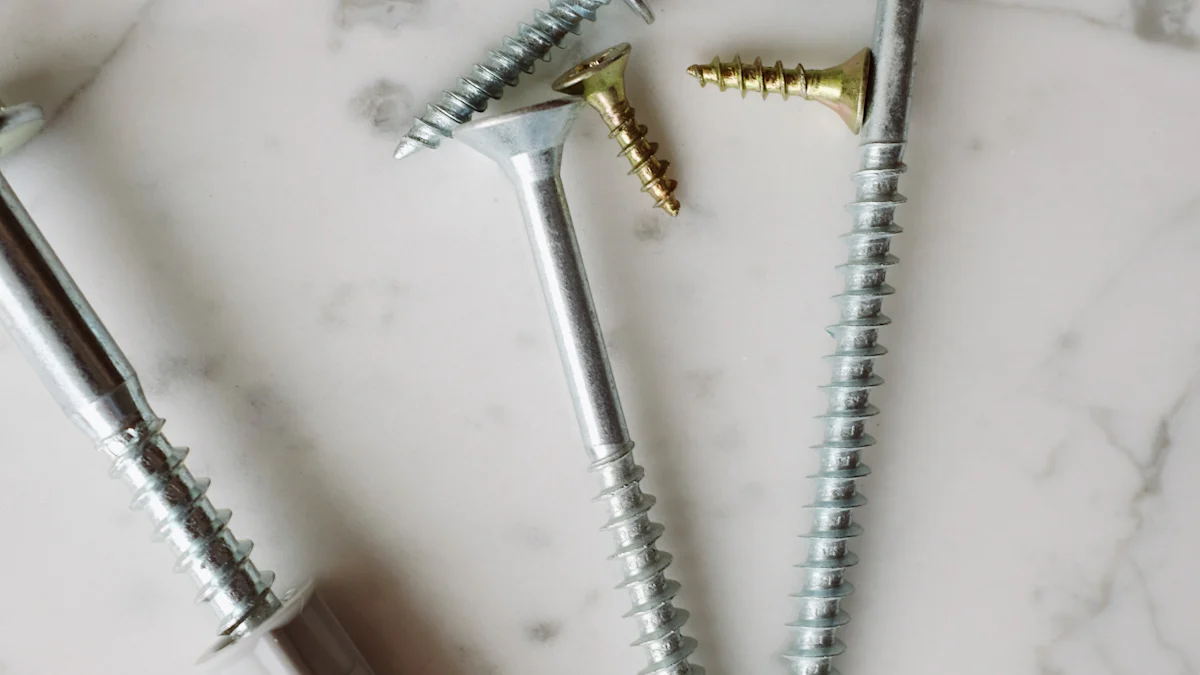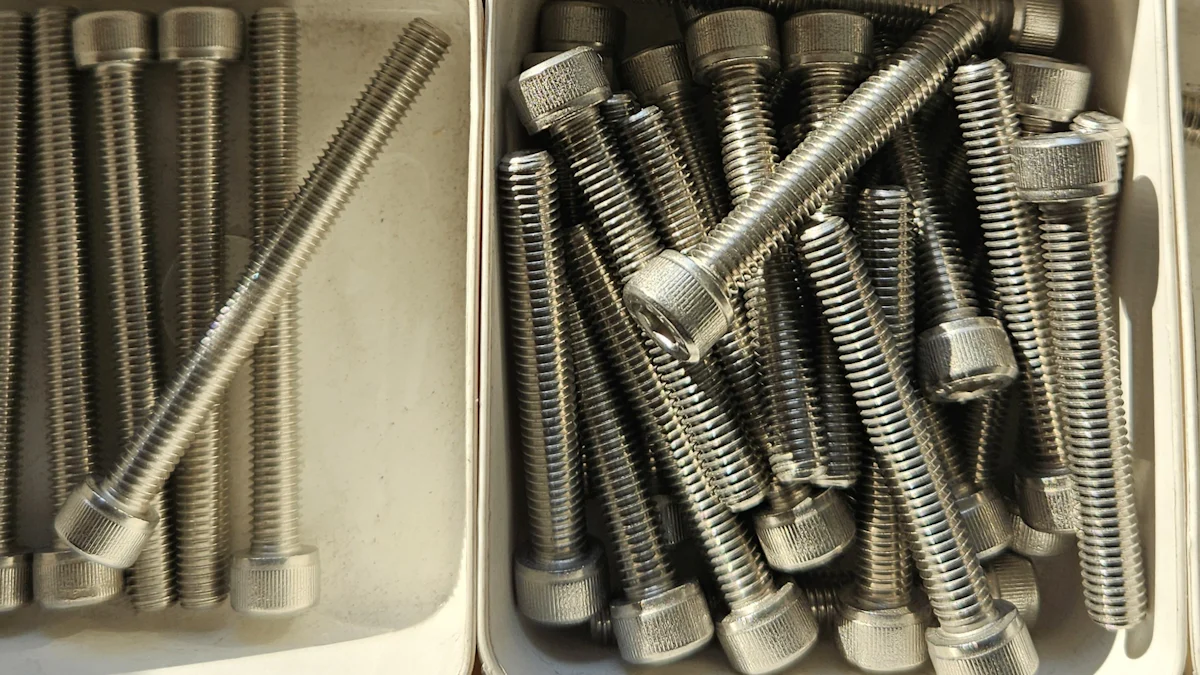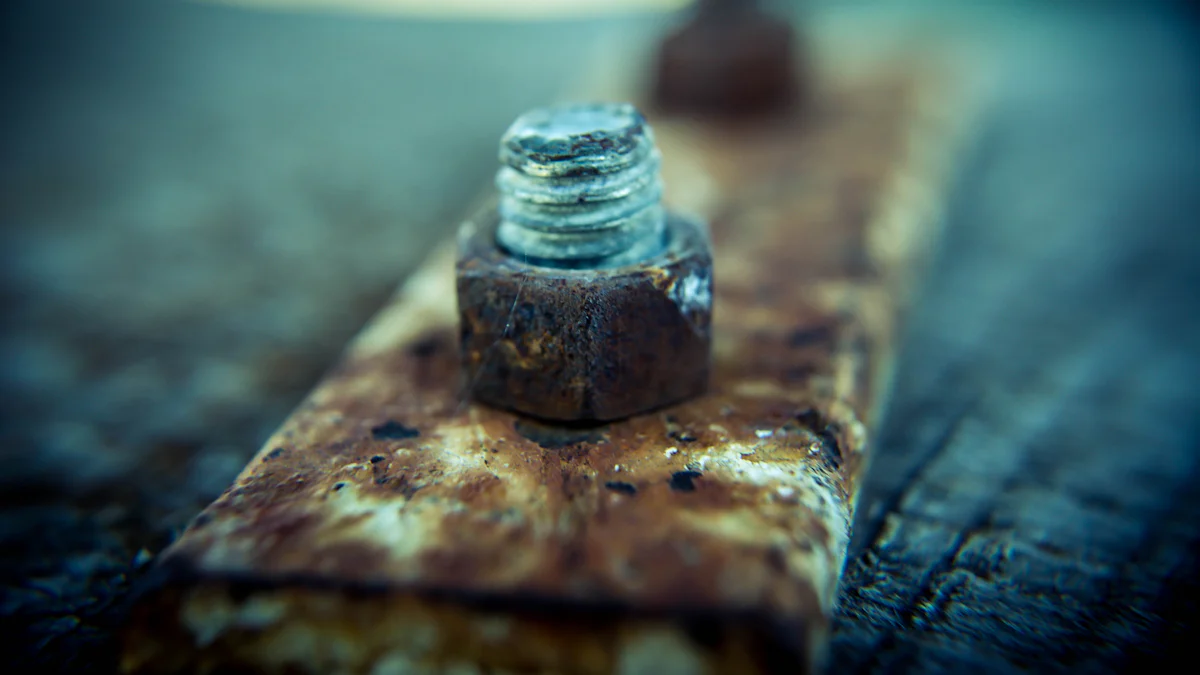How to Cut Machine Screws with the Right Tool

Choosing the right tool for how to cut machine screws is essential. It ensures you achieve precise cuts, maintain safety, and work efficiently. Using improper tools can lead to damaged threads, uneven cuts, or even broken equipment. Experts emphasize that accurate measurements and proper tools prevent these issues. Tools like hacksaws, bolt cutters, and rotary tools are highly effective for this task. Each tool offers unique advantages, allowing you to match the tool to the screw's material and size. By selecting the correct tool, you simplify the process and ensure professional results.
Key Takeaways
Choosing the right tool such as hacksaws for smaller screws or bolt cutters for thicker ones, is crucial for achieving clean and precise cuts.
- Always measure and mark the desired length of the screw before cutting to avoid mistakes and ensure accuracy.
- Secure the screw in a vise or clamp to prevent slipping during the cutting process, enhancing safety and precision.
- After cutting, file down any rough edges to ensure a smooth finish, which is essential for proper fit and functionality.
- Prioritize safety by wearing protective gear like safety goggles and gloves to prevent injuries while cutting. Regularly maintain your cutting tools by cleaning, sharpening, and inspecting them for damage to ensure optimal performance and longevity.
- Understand the strengths of hand tools versus power tools to select the best option based on your project needs and experience level.
Tools for Cutting Machine Screws

Choosing the right tool is crucial when learning how to cut machine screws effectively. Each tool offers unique benefits, depending on the material and size of the screw. Below, you’ll find a breakdown of hand tools, power tools, and a comparison to help you make an informed decision.
Hand Tools for Cutting Machine Screws
Hacksaws
A hacksaw is a versatile and affordable tool for cutting machine screws. Its fine-toothed blade allows you to make precise cuts, especially on smaller screws. To use it effectively, secure the screw in a vise and saw steadily along the marked line. This method works best for softer metals and requires patience for clean results.
Bolt Cutters
Bolt cutters are ideal for cutting thicker screws or bolts. These tools come in various sizes, from compact single-handed models to larger two-handed versions. Their sharp, powerful jaws can slice through screws quickly. However, they may leave rough edges, so filing the cut end is necessary for a smooth finish.
Thread-Cutting Pliers
Thread-cutting pliers combine cutting and threading in one tool. They are perfect for small machine screws, as they ensure the threads remain intact after cutting. Electricians often use these pliers for their precision and efficiency. They are a great choice for maintaining the functionality of screws.
Power Tools for Cutting Machine Screws
Rotary Tools (e.g., Dremel)
A rotary tool, such as a Dremel, is excellent for precision cutting. Equipped with a cutting disc, it can handle screws of various materials. This tool is especially useful for intricate projects where accuracy is essential. Always wear safety goggles when using a rotary tool, as it generates sparks and debris.
Angle Grinders
An angle grinder is a powerful option for cutting larger screws or bolts. Its high-speed rotating disc can cut through tough materials like steel. While it offers speed and efficiency, it requires a steady hand to avoid damaging the screw or surrounding surfaces.
Electric Screw Cutters
Electric screw cutters are designed specifically for cutting screws and bolts. They provide clean, precise cuts with minimal effort. These tools are ideal for professionals who need to cut multiple screws quickly. Their ease of use makes them a valuable addition to any workshop.
Comparing Hand Tools and Power Tools
Cost and Accessibility
Hand tools, such as hacksaws and bolt cutters, are generally more affordable and widely available. They are a good choice for occasional use or small projects. Power tools, while more expensive, offer greater efficiency and are worth the investment for frequent or large-scale tasks.
Precision and Control
Hand tools provide better control, making them suitable for delicate work. For example, thread-cutting pliers ensure the screw’s threads remain intact. Power tools, like rotary tools, excel in precision but require practice to master.
Speed and Efficiency
Power tools outperform hand tools in terms of speed. An angle grinder or electric screw cutter can complete the job in seconds. Hand tools, on the other hand, demand more time and effort but are often safer for beginners.
By understanding the strengths of each tool, you can choose the best option for your project. Whether you prefer the simplicity of hand tools or the efficiency of power tools, selecting the right equipment ensures professional results.
How to Cut Machine Screws: Step-by-Step Guide

Cutting machine screws requires careful preparation, proper technique, and attention to detail. By following these steps, you can achieve clean, precise cuts while maintaining the functionality of the screw.
Preparation
Gather the necessary tools and materials.
Start by collecting all the tools and materials you need. Depending on your chosen method, you may require a hacksaw, rotary tool, or bolt cutters. Additional items like a vise, measuring tape, and a file will also come in handy. Having everything ready ensures a smooth workflow.
Measure and mark the desired length of the screw.
Use a measuring tape or ruler to determine the exact length you need. Mark the cutting point with a permanent marker or masking tape. This step helps you avoid mistakes and ensures accuracy.
Secure the screw in a vise or clamp for stability.
Place the screw in a vise or clamp to hold it firmly in place. A stable screw prevents slipping during the cutting process, reducing the risk of uneven cuts or accidents. Tighten the vise enough to secure the screw without damaging its threads.
Cutting Techniques
Using a hacksaw for manual cutting.
A hacksaw is a reliable tool for manual cutting. Position the blade on the marked line and apply steady pressure as you saw back and forth. This method works best for softer metals and smaller screws. Although it takes time, a hacksaw provides good control and precision.
Using a rotary tool for precision cutting.
A rotary tool, such as a Dremel, is ideal for intricate or precise cuts. Attach a cutting disc to the tool and align it with the marked line. Turn on the tool and guide it slowly along the mark. Rotary tools are excellent for cutting screws made of harder materials, but always wear safety goggles to protect your eyes from sparks and debris.
Using bolt cutters for quick cuts.
Bolt cutters are perfect for cutting thicker screws quickly. Position the jaws of the cutter around the marked area and apply firm pressure to make the cut. While this method is fast, it may leave rough edges, so be prepared to file the screw afterward for a smoother finish.
Finishing the Cut
File down rough edges for a smooth finish.
After cutting, inspect the screw for any sharp or uneven edges. Use a metal file to smooth out the cut end. Filing not only improves the appearance but also ensures the screw fits properly into its intended application.
Test the screw to ensure proper fit and functionality.
Finally, test the screw by threading it into its designated hole or nut. This step confirms that the screw fits correctly and functions as intended. If it doesn’t fit, recheck the length and smoothness of the cut, making adjustments as needed.
By following these steps, you can master how to cut machine screws with precision and efficiency. Whether you use a hacksaw, rotary tool, or bolt cutters, proper preparation and technique are key to achieving professional results.
Safety Precautions for Cutting Machine Screws
When cutting machine screws, prioritizing safety is essential. Proper precautions protect you from injuries and ensure a smooth workflow. Follow these guidelines to maintain a safe and efficient working environment.
Personal Protective Equipment (PPE)
Safety goggles to protect your eyes.
Always wear safety goggles when cutting machine screws. Cutting tools, especially power tools like rotary tools or angle grinders, can produce sparks and flying debris. Goggles shield your eyes from potential harm and allow you to focus on the task without distractions.
Gloves to prevent cuts and abrasions.
Protect your hands by wearing durable gloves. Handling sharp tools like hacksaws or bolt cutters increases the risk of cuts and abrasions. Gloves provide a barrier against these hazards while giving you a better grip on tools and materials.
Tip: Choose gloves that fit snugly but allow flexibility. Avoid loose gloves, as they can get caught in power tools.
Safe Work Environment
Ensure a clean, well-lit workspace.
A clean and well-lit workspace minimizes accidents. Remove clutter and unnecessary items from your work area to reduce tripping hazards. Adequate lighting helps you see clearly, ensuring precise cuts and preventing mistakes.
Keep tools and materials organized to avoid accidents.
Organize your tools and materials before starting. Place frequently used items within easy reach. Proper organization prevents accidental tool drops and ensures you can work efficiently without interruptions.
Pro Tip: Use tool holders or racks to keep sharp tools like hacksaws and files safely stored when not in use.
Tool-Specific Safety Tips
Proper handling of sharp tools like hacksaws and bolt cutters.
Handle sharp tools with care to avoid injuries. When using a hacksaw, maintain a firm grip and saw steadily to prevent slipping. For bolt cutters, position the jaws accurately before applying pressure. Always inspect tools for damage before use, as dull or broken tools can cause accidents.
Did You Know? Regular blade sharpening improves cutting efficiency and reduces the risk of accidents caused by excessive force.
Safe operation of power tools to avoid injury.
Power tools require extra caution. Before using tools like rotary tools or angle grinders, read the manufacturer’s instructions thoroughly. Secure the screw firmly in a vise or clamp to prevent movement during cutting. Keep your hands away from the cutting area and turn off the tool immediately after use.
Safety Reminder: Many power tools generate heat during operation. Allow the tool to cool down before handling it to avoid burns.
By following these safety precautions, you can minimize risks and focus on achieving precise, professional results. Always prioritize safety, whether you’re using hand tools or power tools, to ensure a successful and injury-free project.
Tips for Maintaining Cutting Tools
Proper maintenance of your cutting tools ensures they remain effective and safe to use. By following these tips, you can extend the lifespan of your tools and achieve consistent results when learning how to cut machine screws.
Cleaning and Storage
Clean tools after each use to remove debris.
After every use, clean your tools thoroughly to remove any metal shavings, dust, or grease. Debris left on the tool can affect its functionality and lead to dull edges. Use a soft brush or cloth to wipe away particles. For stubborn grime, apply a mild cleaning solution and dry the tool immediately to prevent moisture damage.
Pro Tip: For power tools, pay extra attention to the cutting discs or blades. Keeping them clean ensures smooth operation and reduces wear.
Store tools in a dry, secure location to prevent rust.
Moisture is one of the biggest threats to metal tools. Always store your tools in a dry environment to prevent rust and corrosion. Use a toolbox or a wall-mounted rack to keep them organized and secure. For added protection, apply a light coat of oil to metal surfaces before storage.
Did You Know? Blade guards or protective covers can shield sharp edges from damage and reduce the risk of accidental cuts during storage.
Sharpening and Repairs
Regularly sharpen blades for optimal performance.
Sharp blades are essential for clean and precise cuts. Dull edges require more effort and can damage the screw or tool. Use a sharpening stone or file to maintain the cutting edge. Test the sharpness by lightly running the blade over a piece of scrap material. If it struggles to cut smoothly, it’s time to sharpen.
Safety Reminder: Always wear gloves and handle blades carefully during sharpening to avoid injuries.
Inspect tools for damage and repair or replace as needed.
Before each use, inspect your tools for signs of wear or damage. Look for cracks, loose parts, or bent components. Damaged tools can compromise your safety and the quality of your work. Replace worn-out blades or repair faulty mechanisms promptly to ensure reliable performance.
Quick Tip: Keep a small repair kit handy with replacement parts and basic tools for quick fixes.
Proper Usage
Use tools only for their intended purpose to avoid wear and tear.
Every tool is designed for a specific task. Using a tool incorrectly can lead to premature wear or even breakage. For example, avoid using bolt cutters on screws that are too thick for their capacity. Always match the tool to the material and size of the screw for the best results.
Important Note: Misusing tools not only damages them but also increases the risk of accidents.
Follow manufacturer guidelines for maintenance and care.
Manufacturers provide detailed instructions for maintaining and using their tools. These guidelines include proper cleaning methods, recommended sharpening angles, and storage tips. Adhering to these instructions ensures your tools perform at their best and last longer.
Pro Tip: Keep the user manuals for your tools in a dedicated folder or digital format for easy reference.
By maintaining your cutting tools properly, you can achieve professional results every time. Clean and store them carefully, sharpen them regularly, and use them as intended. These practices not only improve your efficiency but also make the process of cutting machine screws safer and more enjoyable.
Choosing the right tool for cutting machine screws ensures precision, safety, and efficiency in your projects. By following the outlined steps, you can achieve clean cuts and maintain the functionality of your screws. Always prioritize preparation, proper technique, and safety measures to avoid errors or injuries. Regular maintenance of your tools, such as cleaning and sharpening, extends their lifespan and enhances performance. When you care for your tools, you save money, reduce repairs, and improve efficiency. With the right approach, you can master how to cut machine screws effectively and confidently.
FAQ
What is the best tool for cutting machine screws?
The best tool depends on the material and size of the screw. For smaller screws or softer metals, a hacksaw provides precision. For thicker screws, bolt cutters work efficiently. If you need accuracy for intricate projects, a rotary tool like a Dremel is an excellent choice. Always match the tool to your specific project needs.
Can I use regular pliers to cut machine screws?
Regular pliers are not ideal for cutting machine screws. They lack the sharp edges and strength needed for a clean cut. Instead, use thread-cutting pliers, which are specifically designed for this purpose. These pliers ensure the threads remain intact while cutting.
How do I avoid damaging the threads when cutting screws?
To protect the threads, secure the screw in a vise and cut carefully along the marked line. Use tools like thread-cutting pliers or a rotary tool for precision. After cutting, file the edges to smooth out any roughness and maintain the screw's functionality.
Is it necessary to file the screw after cutting?
Yes, filing the screw after cutting is essential. It removes sharp edges and ensures a smooth finish. This step helps the screw fit properly into its designated hole or nut. A metal file works well for this task.
Are power tools better than hand tools for cutting screws?
Power tools offer speed and efficiency, making them ideal for larger projects or harder materials. Hand tools, however, provide better control and are safer for beginners. Your choice should depend on the project requirements and your level of experience.
What safety gear should I wear when cutting machine screws?
Always wear safety goggles to protect your eyes from flying debris. Gloves are also important to prevent cuts and abrasions. For power tools, consider wearing ear protection to reduce noise exposure.
Tip: Choose snug-fitting gloves to maintain flexibility and avoid accidents.
How can I ensure accurate cuts on machine screws?
Start by measuring and marking the desired length with a permanent marker or masking tape. Secure the screw in a vise to keep it stable. Use a steady hand and follow the marked line closely with your chosen tool.
Can I reuse the cut-off portion of a machine screw?
Reusing the cut-off portion is possible if the threads remain intact and the length suits your needs. File the cut end to smooth it out before using it. However, always test the piece to ensure it functions properly.
How often should I sharpen my cutting tools?
Sharpen your tools whenever you notice dull edges or reduced performance. Regular sharpening ensures clean cuts and reduces the effort required. For power tools, check the cutting discs or blades periodically and replace them if necessary.
What is the most common mistake when cutting machine screws?
The most common mistake is using the wrong tool for the job. This can lead to uneven cuts, damaged threads, or even broken tools. Always select a tool suited to the screw's material and size, and follow proper cutting techniques for the best results.
See Also
Guide to Metal Cutting Using Your CNC Desktop Machine
Simple Methods for Thread Cutting on Sewing Machines
Advice for Efficient Wood Cutting Using Cricut Machines
